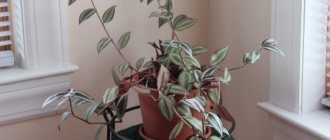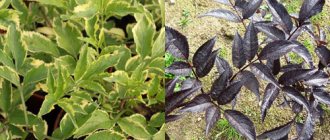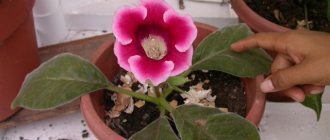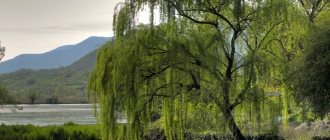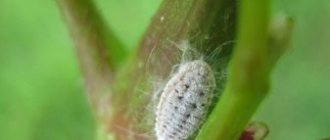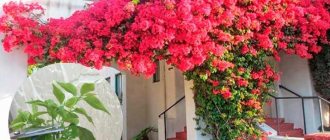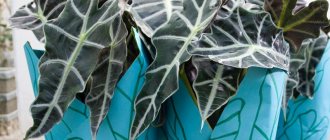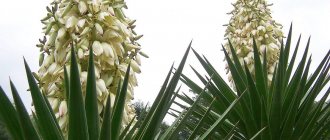Botanical description
Tradescantia (oysters, cradle lilies, spider lilies) belong to the Commelionaceae family and are classified as a separate genus consisting of 75 species. These are herbaceous perennials , the maximum height of which is 60 cm. The stems are most often creeping and thin.
They grow in groups or separately in fields and forests. The length, shape, and color of the foliage depend on the species (green or variegated). The surface of the plates may be pubescent.
The inflorescences are paniculate, the flowers (blue, violet, light blue, pink, white), consist of three petals and six stamens (sometimes four petals and eight stamens), close during the day in sunny weather. Each individual flower lives only one day , but the large number of buds ensures continuous flowering from spring to autumn. Tradescantia juice is clear and sticky.
The natural conditions of this plant are America (from Mexico to Canada). Species imported from the tropics are grown as indoor flowers. Suitable for open ground are varieties bred from Tradescantia growing in the north of the American continent, where they are called arachnids.
What it looks like, what family it belongs to
Tradescantia is one of the most common indoor plants. Her flowers are small and modest. The fruits are small shaped capsules, each containing several seeds.
Tradescantia is grown in greenhouses and in open ground
The hanging plant is used for landscaping both brightly lit rooms and shaded rooms. Indoor Tradescantia looks good on high stands and in hanging flowerpots; it is used to decorate arches and niches. By combining different types, you can create hanging gardens, giving the indoor space a feeling of lightness and airiness.
Additional Information! Tsiolkovsky also spoke about the need to use plants on long flights to ensure breathing and nutrition for people. In 1960, plants made their first space flight, and Tradescantia was among them!
The chemical composition of the plant determines the ability to purify the air from harmful impurities and increase the humidity of the external environment. Phytoncides secreted by Tradescantia suppress the development of fungi and bacteria.
Tradescantia ampelous also has medicinal properties, which have long been noticed by traditional medicine. Diluted fresh juice is used for sore throats to gargle, and the decoction is used to rinse the nose. Tinctures are used to cleanse the intestines. In places where it grows naturally, the juice of the flower is used as a wound-healing agent, lubricating cuts and bruises.
Description
Tradescantia is a perennial vine and has about a hundred varieties. The plant came to Europe thanks to the traveler John Tradescant, who was a gardener at the royal court of Great Britain. This unusual culture was named in his honor. As a rule, Tradescantia is grown as an indoor flower, but hybrids have been bred that take root well in open soil.
The colorful shoots of bright green color add a special charm to the plant. They fall beautifully in a luxurious cascade from the flower pots. The leaf blades are smooth or grooved, their shape can be either lanceolate or oval. They grow on short petioles. Arc-shaped or parallel veins are clearly visible on the surface.
Because of the elongated intertwined shoots, Tradescantia is also called “woman's gossip.”
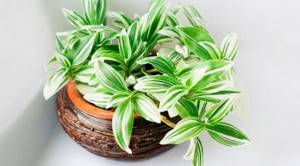
Varieties of the plant have a variety of leaf colors. There are specimens with both solid green leaves and variegated ones, decorated with stripes of various shades. Tradescantia flowers are small, with three delicate petals. Their colors can be different: white, pink, blue or purple. The flowers are collected in a few apical inflorescences located in the axils of the leaf blades.
At home, not all varieties are pleasing with flowering. Mostly hybrids and garden species bloom. Tradescantia well moisturizes the air around it, and also has the ability to neutralize pathogens near itself and dampen electromagnetic rays from electrical appliances.
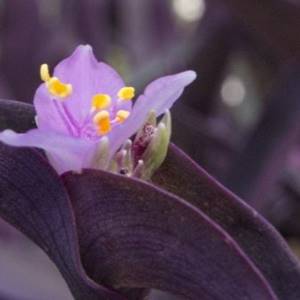
Rules of care
Tradescantia is famous for its unpretentiousness and rare endurance . Its main, but easily fulfilled condition is a sufficient amount of light.
This plant loves bright, but at the same time diffused lighting and will be grateful for direct sunlight in the morning and evening hours. This can be provided to him on the eastern or western windowsill.
Tradescantia can easily tolerate partial shade , but then its shoots become very elongated, and the variegated varieties lose their original coloring. However, this plant does not give up so easily and is able to regain its former splendor. You just need to provide Tradescantia with the right lighting, and its leaves will once again be decorated with unique striped patterns.
Unfortunately, Tradescantia ages quite quickly , as a result of which its stems, losing leaves, become bare and the beauty loses its decorative effect.
To save their pet, flower growers practice annual plant rejuvenation by short pruning, pinching shoots and replanting in new soil .
Learn more about caring for Tradescantia from the video presentation:
Garden tradescantia are even more hardy than indoor ones . In warm winters they do not even require shelter. It doesn’t hurt to just mulch the young bushes with peat or dry leaves for the winter.
Purchase and adaptation
Tradescantia needs adaptation after purchase. This is especially true for exotic varieties. They are transported in special containers with peat substrate - the flower will not live in them for long.
Be sure to check the soil in which the flower grows. If necessary, immediately transplant it into a more suitable substrate.
Quarantine lasts 2-3 weeks. The plant should be placed separately from other crops already in the house. It may harbor pests or be a carrier of infection.
Tradescantia small-leaved: home care
Tradescantia - home care
This is the most delicate and miniature of the entire variety of Tradescantia. The shoots and the underside of the green leaves are purple. The leaves are round, slightly pointed, no more than 0.6 cm in length. It grows quickly and densely, looks best in a hanging pot, elegantly hanging its shoots.
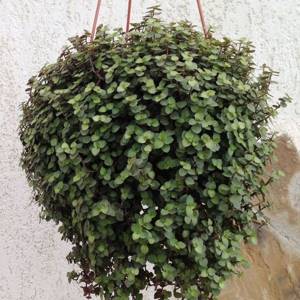
A variety of Tradescantia with small leaves
Despite its fragile appearance, small-leaved Tradescantia is a very tenacious and strong plant. It takes root quickly and has no special care requirements. Loves light, warmth and abundant moisture. It can easily grow entirely under artificial light; the lack of light is manifested by elongated shoots and sparse leaves on them.
Direct rays can leave burns on the leaves or deprive them of their rich green color. In summer, watering should be daily, as should spraying. In winter, temperatures below 15°C are preferable, although Tradescantia easily tolerates drops of up to 10°C.
Note! Watering in winter is reduced as the soil dries out. If the air is dry, spraying is also necessary in winter.
To grow a lush bush, it is imperative to pinch and shorten long shoots. Every spring, during transfer to a larger pot, the crown of the future plant should be formed. After transplantation, it is advisable to feed with organic and mineral fertilizers every two weeks until autumn. You need to care after transplantation, focusing on maintaining heat and humidity.

Home care for Tradescantia Reo is similar to the small-leaved species
Temperature and lighting
Tradescantia is comfortable at 22-26 degrees in summer. In winter it needs coolness. It is important that the thermometer is within 11-13 degrees. If the room is warmer, you need to provide additional light.
Note! The plant does not like direct sunlight and can be kept in partial shade.
True, the striped, variegated Tradescantia will then lose its attractive pattern. The stripes on the leaves will become faded. Lack of home care for Tradescantia violet, in particular lack of light, will cause the stems to become thin. The rich purple tint will disappear.
Riverside tradescantia (tradescantia fluminensis) will change appearance when exposed to excessive light. The leaves have different colors depending on the variety. Some combine large green and pink stripes, while others have slightly visible white lines and dots on a bright green background.
The variegated Tradescantia has a purple back side of the leaf. And on the front side there are golden stripes. The pattern of leaf plates will even out in the bright sun. They will become light and monochromatic.
Humidity
30-40% humidity is enough; there is no need to raise it artificially. No pallets with soaked expanded clay or wet rags on the radiator - this is unnecessary.
Tradescantia easily tolerates ordinary apartment microclimates. Only during a period of prolonged drought, when the house is hot, spray the flower with water from a spray bottle.
Watering
From April to October the plant needs plenty of moisture. Usually at this time I water my Tradescantia once every two days. It is important to prevent deep layers of soil from drying out or excessive accumulation of water in it.
In winter, subject to optimal temperature conditions, on average, Tradescantia is watered once every five days. For irrigation, only settled water at room temperature is used.
Top dressing
Feeding Tradescantia is mandatory during the period of active growth, namely from March to September - October. In winter, if the plant has a dormant period (it is kept at low temperatures), fertilizing is not needed. If in winter Tradescantia is located in rooms with high air temperatures, and there is no dormant period as such, then fertilizing can be continued, but its frequency can be reduced.
Any complex mineral fertilizer is suitable for fertilizing Tradescantia. The frequency is usually once a week in the summer, and once every 2-3 weeks in the winter.
Recent posts Why birch leaves can be useful for the garden 6 unobvious reasons to plant hydrangea in the garden Why soda is considered a universal and effective tool for the garden and vegetable garden

To fertilize Tradescantia, any complex fertilizer that can be purchased in the store is suitable.
Transplanting Tradescantia
Young growing specimens are replanted every spring. Or even twice a season if the plant has greatly outgrown the planting capacity. Mature plants - once every 2 years. But in the spring it is advisable for them to add fresh soil.
If you do not want the plant to grow too much, then its growth can be restrained by the volume of the pot. Having chosen the optimal volume of the plant, you can replant it in the same pot from year to year. At the same time, trimming the roots, shaking off the soil around the root as much as possible. And the lashes can be cut in half, or at the base. Rule: the more you trim the root system, the more radically you need to trim the above-ground part. This is done in order to relieve the load on the remaining root.
Substrate for Tradescantia
Tradescantia, without exaggeration, can grow in almost any soil. Preferable is a ready-made “universal soil” for indoor plants. You can add a little sand. Choose high-quality soils. To make your own soil mixture:
Sod land - 1 part; Deciduous - 2 parts; Peat - 1 part; Sand - 1 part.
Don't forget to put drainage at the bottom of the container.
Flowering period
Although Tradescantia is mainly grown for its beautiful cascading shoots with colorful decorative foliage, the flowering of most varieties is also of interest. White, purple, pink or blue small flowers located in the axils of the leaves and at the ends of the shoots, combined with the rich color of the foliage, give the plant a special charm. The flowering of indoor Tradescantia can be stimulated by cold wintering, reducing the frequency of watering, and changing lighting conditions.
If the problem of inconsistent flowering has arisen in garden varieties of Tradescantia, then most likely it is due to unfavorable growing conditions, insufficient watering, and the need to renew the plant (usually every 4–5 years).
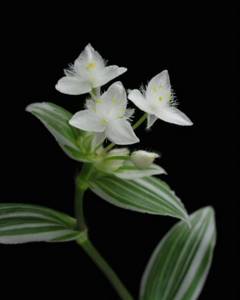
Flowering of indoor tradescantia can be stimulated by cold wintering and reducing the frequency of watering
Lighting and location selection
Tradescantia can grow both in a bright place and in a shaded one, although in the first case this will contribute to rapid growth. The choice of the place where the flower will grow should be approached responsibly, especially if you grow variegated Tradescantia. Care and sufficient light will make the color of the leaves more vibrant.
Important! Plants with monochromatic leaves that are green in color, on the contrary, in the sun, losing contrast, become faded, and in the shade they acquire a rich shade.
How to choose a pot
Since the root system grows proportionally in different directions, a standard-sized pot is selected for Tradescantia. So-called tulip pots or trapezoidal pots are sold on store shelves. The top of such a container is 3 cm larger than the diameter of the bottom. It is easy to remove the flower from them when transplanting. The material of the “new house” can be varied: plastic, ceramics, metal. By the way, it’s better to hang the pots.
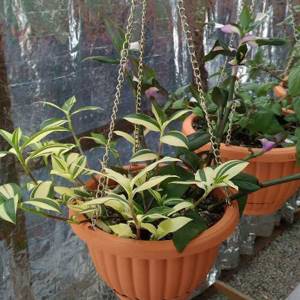
In the photo, the most successful location of the pots is in a suspended state. By the way, there are two types of Tradescantia in one pot. They are able to grow without interfering with each other in the same soil.
How to prune tradescantia
To ensure that the plant has a neat shape, trim its vines. This can be done in spring, summer and even early autumn, while Tradescantia is actively growing.
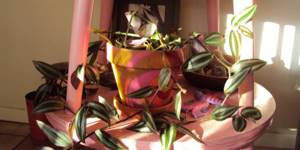
Tradescantia with elongated stems
Trim with scissors, a sharp knife, or simply carefully break off fairly fragile stems.
Cut off shoots take root easily in water. There should be no more than a third of the plant in the liquid. After a week or a week and a half, roots will appear. After this, Tradescantia can be planted in a pot with soil.

Young plant with roots
You can root the shoot directly in the ground. To do this, place one or more cuttings in a pot so that only the very end of the stem is in the ground. Until the Tradescantia begins to grow, water a little every couple of days. Afterwards - in normal mode.
Cuttings can also be used to rejuvenate Tradescantia. If it grows too long and the stems become bare and lose their decorative effect, simply re-grow the flower from the petiole.
Reproduction
For propagation, you can use seeds and cuttings. Tradescantia tolerates dividing bushes well.
Rooting cuttings
On the hanging branches of Tradescantia there are always barely noticeable rudiments of roots. If the shoot “reaches” the soil, it immediately clings to the ground, which is successfully used during propagation. A pot with a moist substrate is placed next to the main plant, one of the lower shoots is bent to it and secured to the ground with a pin. The roots almost immediately begin to grow into the soil, and a new bush is formed.
The finished rooted bush is cut off from the mother plant and grown separately.
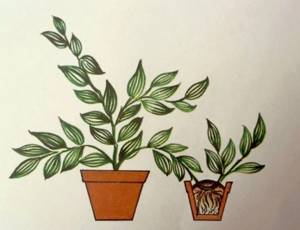
Growing from seeds
This method is quite rarely used by flower growers , since the seeds take a very long time to germinate and the plant begins to bloom only in the third year. First, flower growers purchase planting material from a specialized store and prepare a fertile mixture of turf soil, peat and sand. At the bottom of the container, gardeners lay out a drainage layer of expanded clay or small stones, pour in prepared soil and moisten it abundantly.
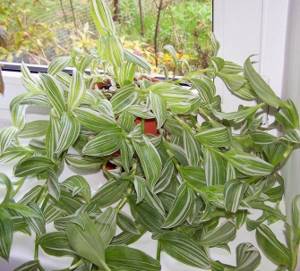
To plant seeds, they are simply spread over the surface of the soil and sprinkled with a thin layer of light soil. The top layer is once again moistened by the gardener using a spray bottle, then the container is covered with plastic film with small holes for ventilation . The container is placed in a bright and warm place with a temperature of at least 20° C. When the first shoots appear, the film is removed. After the third leaf appears, the seedlings are transplanted into separate pots.

Cuttings
The simplest and most popular way. For cuttings, choose strong mature shoots and cut cuttings up to 15 cm long. The cuts are made under the nodes so that each of the cuttings ends up with buds. The cuttings are dipped in water to form roots.
After about 10 days, small roots (about 5 cm) grow. Rooted cuttings should be planted in pots, maybe several in each. To enhance the branching of the bush, shortening the stems is practiced. The correct composition of the soil mixture is the key to good development of cuttings. It should include compost soil, humus and river sand.
Some gardeners plant cuttings directly into pots with substrate, without rooting in water. At a temperature of approximately +20 degrees and diffused lighting, the roots will successfully grow in the substrate, and shoots with numerous branches and beautiful foliage will form from the buds on the cuttings. With full compliance with agricultural technology, in 1–1.5 months a completely decorative bush will grow.
Dividing the bush
This procedure is carried out in the spring. The plant is dug out of the pot, the roots are cleared of soil and cut into pieces with a sharp garden knife. The cut areas are sprinkled with wood ash (or activated carbon) and placed in prepared containers with substrate.
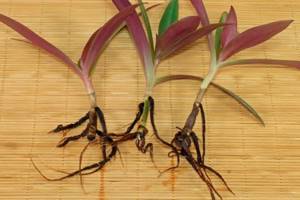
Types and varieties of Tradescantia
There are about one hundred species and varieties of this plant. Let us introduce you to the most common ones.
White-flowered (Albiflora)
This species has long bending shoots that grow up to 50 cm. The leaves are large, ovoid-oval, monochromatic or painted with alternating stripes of white and pale green. The bottom of the leaf is slightly lighter than the top. The edges of the leaf blade are pointed. The surface is glossy. It blooms on the tops of the shoots with small flowers in the form of umbrellas of white or pale pink color.
This may be interesting: Aglaonema - 20 popular species and varieties
Varieties of white-flowered tradescantia:

Aurea - its yellow leaves are dotted with green stripes
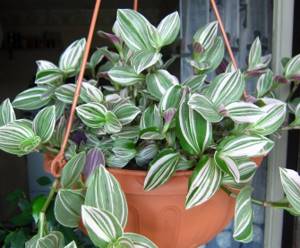
Tricolor - its green leaf plate is decorated with stripes of white, pink and lilac colors
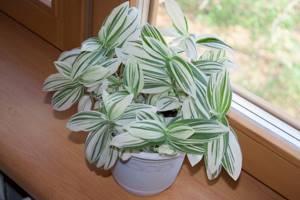
Albovittata - white stripes of different sizes run along the green background of the leaf
Striped or Zebrina
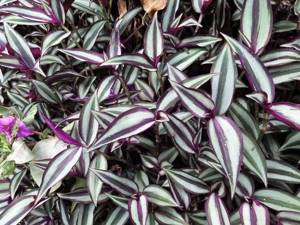
She is one of the most beloved among flower growers; without exaggeration, we can say - a real beauty! It has a strong stem up to 50 cm in height. The leaves are also long, up to 30 cm, their width is 5-6 cm. The color of the leaf below is unusually lilac-violet in color, and the top is covered with silver, purple and white longitudinal stripes. It blooms with purple or violet small flowers.
Blossfeldiana
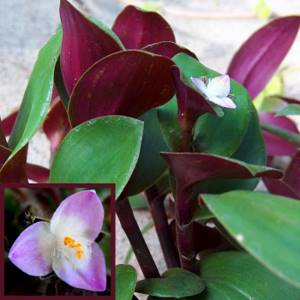
This type of Tradescantia has dense, dark green, lanceolate-shaped leaves with a sharp tip and are quite large in size. The upper side of the leaf has a rich green color with a soft reddish tint. The lower part of the leaf is dark purple, with soft fibers. The stems of the plant are dense and have a burgundy-green sheath. They are also covered with lint. Three-petalled inflorescences of a delicate lilac color may appear in the axils of the leaves. The stamens and sepals are covered with long silvery fibers.
Scaphoid (Navicularis)
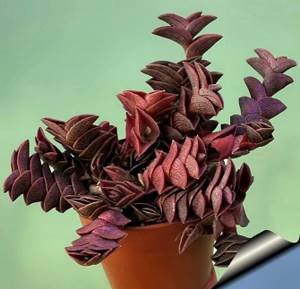
This is the most unusual type of indoor tradescantia. It has decorative creeping stems of a green-violet hue with raised tips and thick small leaves, reminiscent of a boat in shape. The leaves are arranged very tightly among themselves and are closely pressed against the shoots. The color of the leaf blades can be different: green, red or purple.
Riverside or Myrtle-leaved (Fluminensis)

Wild specimens of this type of Tradescantia have even green leaves. The flowers are white, small, with bright yellow stamens.
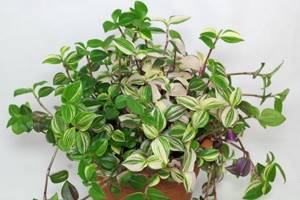
But, at home you can find plants with striped or even spotted leaves. Its shoots are thin, purple-red in color. The leaves are oval, bright green, small. On the underside they are lilac-violet.
Hairy (Sillamontana)
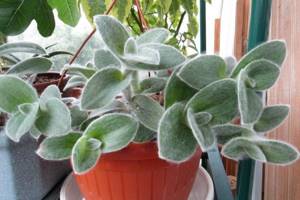
This is the only type of Tradescantia that can live in dry conditions due to the fact that its stems and leaves are covered with long whitish hairs that help accumulate and retain moisture, protecting the plant from loss of it. The shoots grow vertically, but droop with age.
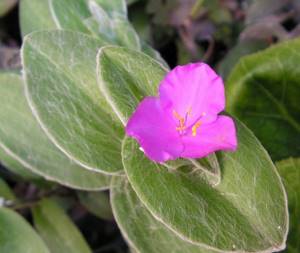
In the summer, single pink flowers with a lilac tint form on the tops of the shoots of Tradescantia Sillamontana.
The species cannot live in cold conditions, so in winter it must be kept in a warm room.
This may be interesting: Popular species and hybrid varieties of Dieffenbachia
Virgin (Virginiana)
This species is characterized by straight, branched shoots up to 50-60 cm in length. The leaves are lanceolate, 20 cm long and 4 cm wide. Their base is covered with thin, soft fibers. In mid-summer it blooms with purple or pink flowers that form dense umbrella inflorescences. Flowering lasts about 2 months.
This species can be grown in garden plots as a beautiful flowering perennial, as it is very hardy and tolerates winter well.
Varieties of Virginia Tradescantia differ in different shades of petals:

Rubra

Atrorubra
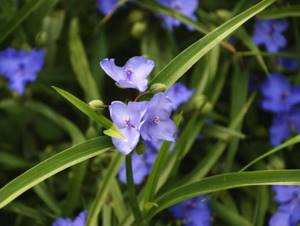
Caerulea
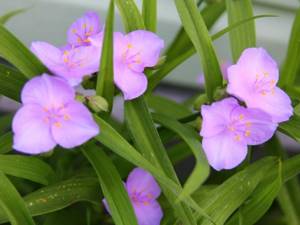
Rosea
Andersona
This species includes hybrids bred by breeders based on Tradescantia virginiana. They have well-branched straight stems, reaching 80 cm, on which voluminous, slightly elongated leaves grow. Tradescantia blooms all summer long with flowers with flat three petals in blue, white, pink or purple shades.
Its most famous varieties:
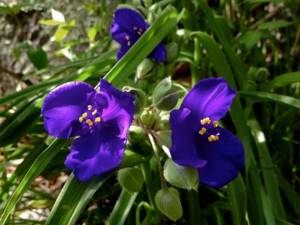
Iris – with flowers of intense blue tone
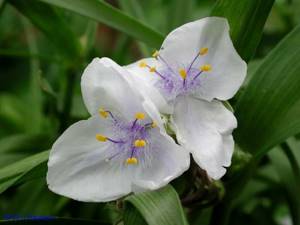
"Osprey" - with snow-white flowers
Purple (Pallida Purpurea)
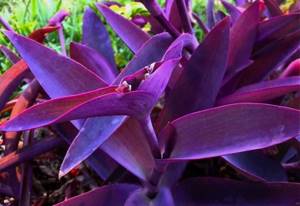
This species has fairly branched stems of a deep purple hue. The leaf blades are the same purple, their lower part is covered with pile. The flowers are small, three-petaled, delicate crimson or pink. During flowering, its bright purple leaves are made even more beautiful by the large number of light pink flowers.
Small-leaved (Callisia)
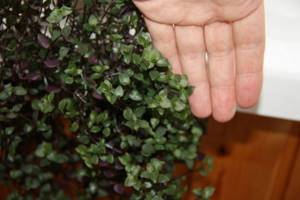
This decorative species is cultivated exclusively for indoor cultivation. Its thin brownish-purple shoots are abundantly covered with tiny smooth leaves - dark green on top and purple on the back.
Bedspreada (Spathacea)
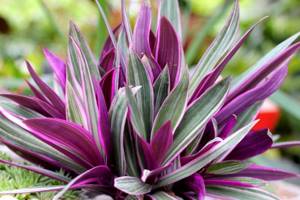
This species is distinguished by an erect shoot, around which a strong rosette of lanceolate-shaped leaf plates is formed. The surface of the leaf plate is glossy, green on the front side and pinkish-violet on the back. The flowering period is short. The flowers are small and white. They form under a blanket that looks like a boat. This feature gave the species another name - “Boat of Moses”.
Lodges
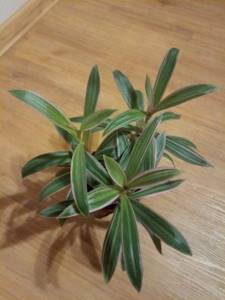
This species is native to Australia. It differs from other relatives in that it does not develop long shoots. The leaves are large, olive green in color with a silver stripe in the middle. The shape of the leaves resembles an elongated oval and forms a rosette at the bottom.
Problems
Tradescantia can suffer and lose its beautiful appearance due to lack of water, light and very dry air.
If the plant is poorly watered and the earthen ball is too dry, its leaves and stems become lethargic.
With prolonged drying of the soil, the leaves turn yellow and become covered with spots. In this case, it is necessary to water the flower more often and more abundantly.
Tradescantia loses its variegation only when it is in a very shaded place. At the same time, its colored leaves may turn green and growth may slow down.
Very dry air also has a negative effect on the plant . Its leaves begin to dry out at the tips and then fall off. To increase humidity, it is necessary to spray the plant.
Growing and caring for Tradescantia Blossfeld
Tradescantia blossfeldiana has long, fleshy leaves that are red on the underside.
As you can see in the photo, the Variegata form of this type of Tradescantia has creamy green leaves that turn pink in the light:
- Family: Commelinaceae (Commelineaceae).
- Homeland: South America.
- Location: As bright as possible, but protected from direct sun.
- Temperature: Room; in winter and cooler, not lower than 10 ° C.
- Humidity: Tolerates dry air.
- Substrate: Flower soil mixture.
- Watering: Maintain moisture.
- Feeding: When caring for this home tradescantia, fertilizers need to be applied every 4 weeks; no feeding is required in winter.
- Replanting: It is better to grow new plants every year.
- Pruning: Trim the tops regularly to ensure thicker growth.
- Reproduction: Cuttings.
- Pests, diseases: Rare.
Beneficial features
Not everyone knows that Tradescantia is a medicinal plant. A leaf applied and fixed to the affected area will heal minor cuts and scratches. Tradescantia juice rubbed into the gums will help cope with periodontal disease. Preparations based on the plant are used in the treatment of acute respiratory viral infections, diseases of the throat and gastrointestinal tract.
Indoors, Tradescantia helps purify the air and neutralizes electromagnetic radiation.

Tradescantia is a very useful plant
It is very easy to keep tradescantia at home. It can be called a leader among the most undemanding indoor plants. It is so unpretentious that even a novice gardener can cope with its cultivation. Thanks to its ease of care, Tradescantia is successfully used for landscaping apartments, offices, and other premises. The plant gets along well with other representatives of the green world, so it often decorates flower arrangements in flower beds, winter gardens, green corners; this plant will even live in an aquarium. Tradescantia looks great both in hanging pots and as a ground cover plant.
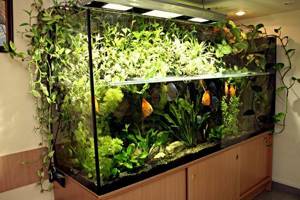
This amazing plant can even live in an aquarium.
The Tradescantia genus has many varieties and species. Among them there are ground covers, ampelous and bush-like varieties (mainly those grown outdoors). About 70 species are successfully grown indoors.
Photo of tradescantia
Read here Lilies of the valley - tips for planting, care and options for use in landscape and garden design (115 photos and videos)
Did you like the article?
0
Signs and superstitions
Tradescantia is one of the few plants that have the property of protecting its owner. This flower is associated with the following beliefs:
– the presence of tradescantia in the house protects the owner from evil intentions and limits him from the influence of visitors who have bad thoughts;
– a flower clears space from various negative entities if it feels the owner’s care for itself;
– the sudden drying of Tradescantia signals the removal of damage or the evil eye from the owner;
– some consider tradescantia an unsuitable flower for the home, as it can lead to excessive anxiety;
– the plant promotes positive changes and the achievement of any results.
Sources
- https://prorasteniya.com/komnatnye/ampelnye/tradeskantsiya.html
- https://pocvetam.ru/komnatnye-rasteniya/ampelnye-rasteniya/tradeskantsiya-komnatnaya.html
- https://stroy-podskazka.ru/tradeskanciya/vidy-i-sorta/
- https://dacha.help/cvety/tradeskantsiya-uhod-v-domashnih-usloviyah
- https://stroy-podskazka.ru/tradeskanciya/vidy/
- https://FermoVed.ru/tsvetyi/tradeskanciya.html
- https://pocvetam.ru/komnatnye-rasteniya/tradeskancia-razmnozenie.html
- https://greensotka.ru/dekorativno-listvennye/tradeskantsiya-ukhod-v-domashnikh-usloviyakh.html
- https://zen.yandex.ru/media/id/5d654e528f011100ad81e307/tradeskanciia-sekrety-pravilnogo-uhoda-v-domashnih-usloviiah-5ee8bb1d987ef673f1bcf280
- https://diz-cafe.com/rastenija/tradeskantsiya-uhod-v-domashnih-usloviyah.html
- https://jplant.info/uxod-za-komnatnoj-tradeskanciej-uxod-za-komnatnoj-tradeskanciej/
- https://pocvetam.ru/komnatnye-rasteniya/tradeskancia-uhod-v-domasnih-usloviah.html
- https://small-village.com/rastenija/tradeskanciya-uhod-v-domashnih-usloviyah.html
- https://Lifehacker.ru/tradeskanciya-uxod/
- https://stroy-podskazka.ru/tradeskanciya/sposoby-razmnozheniya/
- https://pion.guru/rasteniya/tradeskantsiya
- https://TheFlowers.su/komnatnye-tsvety/tradeskantsiya-razmnozhenie.html
- https://room-plant.ru/komnatnye-rasteniya/ampelnye-rasteniya/tradeskantsiya/uhod-za-tradeskantsiej/
[collapse]


